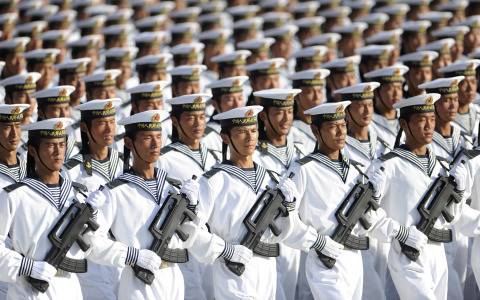Tanks, Artillery, Deception and the RAF
Although popular opinion suggests that the British generals just kept battering away at the German lines in the same old fashion, with the same old results, the truth was very different. Fifty Mark 1 tanks had first been employed at the end of the Battle of the Somme in September 1916 in a desperate attempt to turn around a failed offensive. Not surprisingly, due to their initial design form making them slow and hard to control, they met with very limited success. However, the British and the French saw the potential of the new weapon for offense and became committed to the tank’s development as a war-winning weapon, while the Germans, perhaps because they were predominantly operating on the defensive, did not embrace the tank’s potential.
Mark V* tank in Amines colours
The British development of an effective tank design and the necessary accompanying tactics naturally took time and combat experience to develop. During the onslaught of the almost overwhelming Spring Offensive of 1918, the tank was ineffective in defence as it could not fight whilst moving in reverse and was very slow. Instead, the battalions of the new Mark V tanks were built and prepared for the right offensive opportunity. Their key role was to break through the fields of barbed wire, which removed the necessity for the artillery fire that had previously been used to cut the wire, which had simply warned the Germans of the impending attack, sending them to ground in their deep, well-built bunkers, only to emerge once the shelling had lifted and begin a withering machine-gun defence of their positions. In what was a game-changing scenario, the heavy British tank returned tactical surprise to the battlefield and encouraged the infantry to attack with new vigour and confidence.
Most importantly of all, and yet hardly discussed in the history texts, from 1917 onwards, British attacks employed strategic deception well before any attack was launched, misdirecting the Germans as to their location. Indeed, the Battle of Amiens came as a complete surprise to the Germans because of the success of the British deception plan and the great care taken in maintaining secrecy. One example of the main strategy involved the Canadian Corps, the subject of close scrutiny as the Germans considered them to be the best assault division in the BEF. Instead of being pre-positioned on the battle line, the Canadians had been moved by rail from positions further up the line. But to add to the Germans’ confusion, a British sleight of hand made it seem to German eyes that they were being sent north, when in reality they were moving south to join the 4th Army. This allowed the Canadians to move into front-line assault positions without German knowledge. Not only was this a masterly stroke of deception, but one of planning as some 20,000 men and their guns were moved in 24 hours to a new fighting position on the 4th Army line.
Furthermore, the air war, initially designed for artillery observation, now controlled the skies above the battle, allowing for bombing and strafing of ground troops and tactical and strategic targets. The British had further refined their ground-support tactics to create squadrons that specifically supported the tanks in attack by destroying the anti-tank artillery that lay in their paths and made the tank so vulnerable. Techniques had been practised that enabled plans and tanks to signal to each other during an advance. During the Battle of Amiens, similarly to their successful role against the Spring Offensive, once more RAF planes caused significant damage and confusion to the rear of the German lines. This combination of new weapons and all arms’ tactics was a huge revolution and highly successful on the battlefield.
This new form of warfare was about to come of age, integrating new components into the forerunner of what is known today as the combined arms’ doctrine, employing deception, tanks, artillery, infantry, and aircraft to overwhelm the enemy at specific points. For this reason alone the Battle of Amiens was a significant evolution in modern warfare and showed that the BEF generals were far from their label of donkeys.
A More Realistic Appraisal of Haig and his General
The BEF and its generals inherited from their politicians a very bad strategic situation that almost ended in disaster, if they had not acted with great skill and courage to prevent the swift capture of Paris for the second time. The war on the Western Front could be characterised by four distinct phases:
1. The German opening attack: 28 July–18 November 1914
2. Deadlock: November 1915–21 March 1918
3. The German Spring Offensives: 21 March 1918
4. The BEF and French offensives: 8 August–11 November 1918.
Apart from 1915, when the old BEF had been exhausted and Kitchener’s new BEF was being built, the BEF played a critical role in all phases of the war.
Field Marshal Haig
Over four years of fighting, the BEF had adapted enormously to the demands of the trenches, and certainly more successfully than the German army, which is why it gained such a significant victory at the Battle of Amiens, and for the next 96 days.
In the final analysis, the commanders of the BEF and indeed the BEF itself had by the end of 1918 mastered both defence and offence and as a result were the best combat force on either side of the war. As such, they should be applauded and held in the highest esteem by the British nation. In the end, victory is the only thing that can have any hope of vindicating the terrible loss of life. As the Duke of Wellington said after the carnage of Waterloo:
Believe me, nothing except a battle lost can be half so melancholy as a battle won: the bravery of my troops hitherto saved me from the greater evil; but to win such a battle as this of Waterloo, at the expense of so many gallant friends, could only be termed a heavy misfortune but for the result to the public.[1]
The BEF generals gave this victory to their nation with fewer losses than the French and Germans.
Most importantly it was the judgement of Haig’s soldiers that probably carries the greatest weight. Despite the great trials and knocks to morale the BEF suffered, it maintained its fighting spirit. Apart from the Australian Corps in September 1918, the BEF did not suffer from large-scale rebellion during the war, although in January 1919 the slow speed of demoralisation did result in widespread mutinous outbreaks. This was in sharp contrast to the French and Russian armies in 1917 and the collapse of German morale in summer 1918.
After the war, as Head of the British Legion, Haig continued to be immensely popular with his men who served under him in the BEF.






















